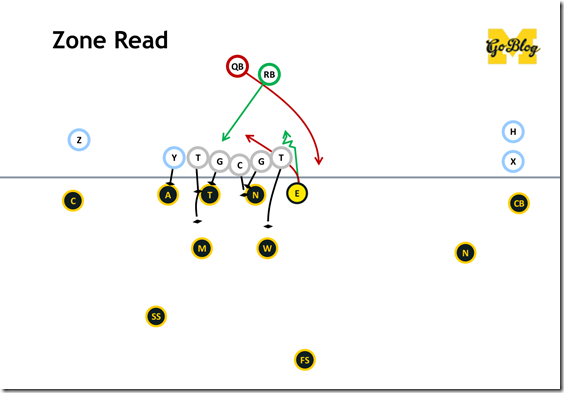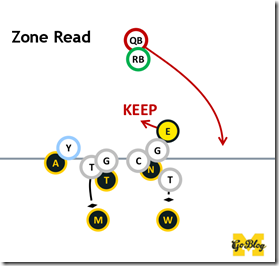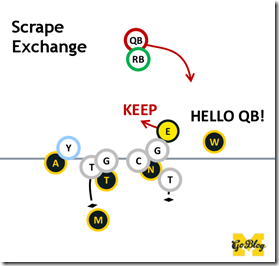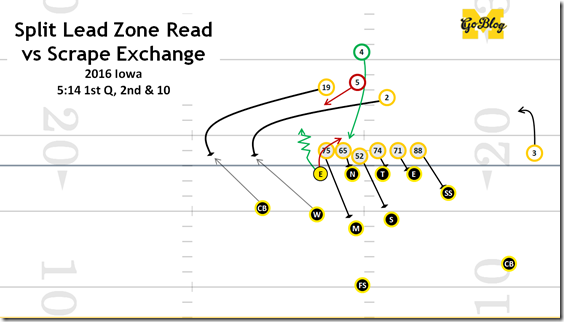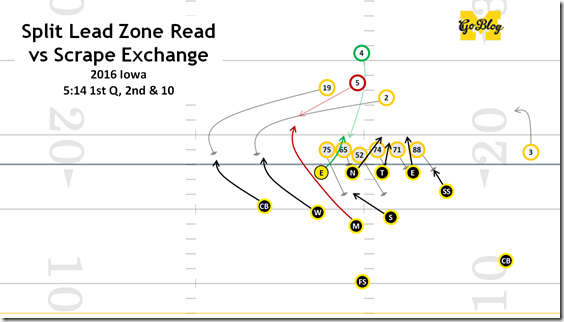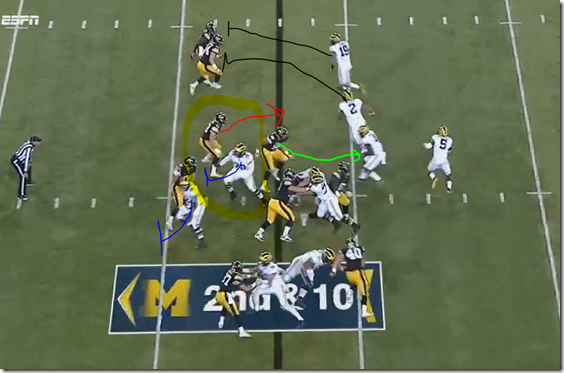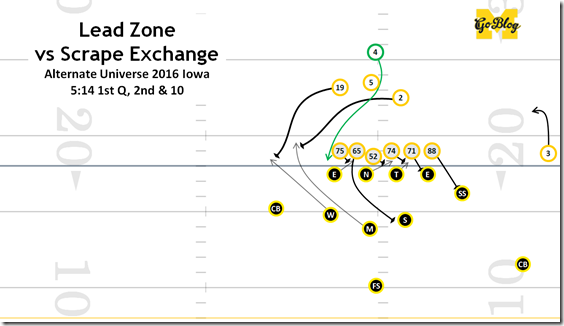[This series is a work-in-progress glossary of football concepts we tend to talk about in Upon Further Review and Neck Sharpies, etc. Previously:
Offensive concepts:Run-pass options (RPOs), High-Low passing routes, Covered (ineligible) receivers/tight ends, Blocking: Reach Blocks, Kickout Blocks, Wham Blocks
Defensive concepts:Keeping Contain/Lane Integrity, Force Player, Hybrid Space Player, One-Gap Fronts, Coverages: Tampa 2, Pattern-Matching, Quarters and how MSU runs it
Special Teams: Spread punt vs NFL-style]
------------------------------------------
In the Iowa UFR Brian talked about how opponents had solved Michigan’s Peppers-as-Option-QB (we were calling it the “Pepcat”) package with an old fashioned zone read beater: the scrape exchange. Brian on the above:
Peppers is reading the DE and pulls; Iowa inserts a linebacker directly into his path since that DE is covering up the inside gaps the LB would usually be tasked with.
Since I watched the Rodriguez era at Michigan this is familiar to me. Also familiar to me: the various counter-punches Michigan threw at this. Remember that brief era when Carlos Brown and Brandon Minor were running directly off tackle for big chunks on the regular? That was due to Michigan's response to this kind of approach: blast that guy slanting even further inside, kick the linebacker out, and thunder directly to the secondary.
Since that was buried in a UFR I figured we might discuss scrape exchanges in some more detail here.
What’s a scrape exchange: It’s adefensive concept that flips the roles of two backside defenders, thus covering both sides of a quarterback’s zone read. The guy the offense thinks it’s optioning, usually a defensive end, “crashes” (move horizontally across the line of scrimmage) and is “exchanged” for another defender, usually a linebacker, who “scrapes” to the area the end vacated.
What’s it for? It’s the paper to the zone read’s rock. So you remember zone read:
This is the play that Rich Rodriguez invented to dawn the spread era. The offense leaves the backside defensive player unblocked and the quarterback options that guy. If the player (usually a defensive end) takes the opportunity of no blocker to scrape across to the running back’s path, the quarterback keeps it and runs into all the space left behind. If the optioned defender forms up to keep the quarterback contained, the running back gets the ball with the benefit of that extra blocker.
After decades there are lots of variations, but this is the gist of that offense. A scrape exchange makes the quarterback keep it, and makes that decision also wrong:
The quarterback running a zone read will see the defensive end crashing and keep the ball, only to find the linebacker appearing where the quarterback was about to run it. What the QB is expecting is on the left below; the result of the scrape exchange is on the right:
[After the JUMP: see it in action, and ways to beat it]
So here’s what Michigan was running versus Iowa:
It’s an unbalanced run outside with two lead blockers, and zone run inside, with a zone read option to decide which. In case Peppers at Wildcat QB wasn’t screaming “run play” already, Michigan has just four eligible receivers (Butt is covered, Magnuson is an ineligible number), and those eligible targets are Poggi, Asiasi, Smith, and Wilton Speight. Asiasi and Poggi lead blockers, the latter being the only one not deep in the backfield. The plan here is defeat the all-important playside end with a zone read, gaining Mags as an extra blocker versus the linebackers. The OL is blocking down like it’s a run to the backside, which ought to pin enough defenders to the wrong side of those blocks that Smith can RAGE past or Peppers and his escort can outflank the rest.
As such Iowa’s got a 4-4 front (bringing down the SS into an OLB role at the bottom), with a safety just 8 yards off the line of scrimmage and a cornerback 7 yards off Speight and cheating inside. That’s fine for Michigan’s purposes since the hope is to flank the Hawkeyes with Peppers or send Smith roaring past the rubble.
But Iowa is ready with the antidote:
The defensive end crashes/scrapes inside to force a pull, and the middle linebacker is going to shuffle wide to where the end would have been if he formed up to stop the QB. Michigan’s extra blocker, Magnuson, has no chance to get that MLB, and has to waste himself on the backside LB you’d want Mason Cole blocking.
Iowa now has a hat for a hat again at the point of attack, with the WLB and CB accounting for Peppers’s escort and the MLB flagging down Peppers.
Video:
What can Michigan do about it?
This is a paper play so of course there are scissors responses, and not just throwing it. I’m sure the coaches knew these responses because they’ve got them in the playbook, just under the guise of the normal Michigan running attack. In fact they ran one such counter almost exclusively to the end zone against Penn State this year:
Watch Magnuson’s block on the first, second (0:10 in the video), and sixth (1:08) plays. Here’s the second play:

Think of how the scrape exchange went down: the defensive end is scraping past Magnuson; what if Mags can just help him do that and seal that guy too far inside?
The DE’s old lane is supposed to go to the MLB, but that guy (Josey Jewell, one of the best linebackers in the best year for linebackers in Big Ten history) is expecting to come up outside and be containing, unblocked. When Jewell got exactly what he expected, he killed the play. But what if instead he gets blindsided by a 250-pound H-back?
In the Iowa setup it might look like this:
There’s one scissors: the DE gets an escort right past the play, the MLB’s exchange takes him too far outside where Asiasi can kick him, and there’s a nice off-tackle hole for Smith to charge into. Peppers just has to be there to look like such a keeper threat that the defense calls an overreaction to it.
When Michigan had an offense predicated on the zone read running game in 2008-’10 we got to see other ways of dealing with it, as Rodriguez schemed to take away the counter to his base play. Rodriguez had a more nefarious plan when Notre Dame was doing this in 2009. He let the DE think he’s unblocked, then pop the dude with a fullback (Asiasi in our case) and charge through the B gap:
As Brian said though, the Pepcat package is just Michigan dabbling their toes into the sea of zone read offense. One of the nice things about the Harabaughffense to date has been this coaching staff’s ability to anticipate how defenses will react to what’s been put on film previously. I’m sure part of that is Harbaugh and Drevno have been running their power offense against defenses a long time and know all the responses to it. You wouldn’t expect them to have the Rich Rod offense down to the same degree, but after running this all year the Iowa game was well past the point when the Pepcat needed a counter to the counter. Scrape exchanges are very much a part of Don Brown’s defenses, so this is hardly a foreign concept to this staff. Hopefully they’ll have something cooked up for FSU.
Additional reading:
- Smart Football on scrape exchanges
- Split zone scissors
- Play-action bubble scissors and another by Blue Bull Run.
- Neck Sharpies: Don Brown’s scrape exchange that almost killed Kizer
